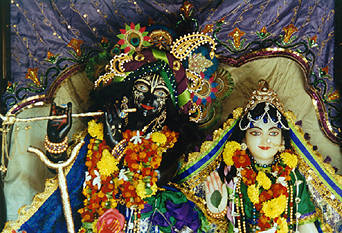From a lecture delivered in Boston MA on July 12 2001

Once we counted Raghunatha Dasa Goswami’s gurus, and we found that he had nine gurus. So then the question is, “Which one of his gurus is most important?” He had nine gurus: Yadunandana Acarya was the mantra guru who gave him initiation, diksa. Then on the way to meet Mahaprabhu, he received the blessing of Nityananda Prabhu, by putting on that yogurt and rice festival; you may have heard about this. Who is Nityananda? He is Baladeva, he is the original guru tattva, so is it possible that he served Nityananda Prabhu and abided by his orders, but he did not find any guru there? Did he only see a Vaisnava there, only a devotee?
No, there is guru tattva; Nityananda is also his guru. Then Nityananda Prabhu sent him to Puri, and Mahaprabhu turned him over to Svarupa Damodara, and said, "You will give him training." Svarupa Damodara became his teacher. Living in Puri at that time was Namacarya Haridasa Thakura. He is the acarya of chanting of the Holy Name; could he just pass him by, saying, "Oh, no he is not my guru?" No, he had to accept him, “He is also my guru, Namacarya Haridasa Thakura.”
Sri Rupa and Sanatana were also living there, the sambhanda acarya and the abhideya acarya -- the foremost of the six Goswamis. First, Raghunatha Dasa Goswami lived in Puri under the care of Mahaprabhu and Svarupa Damodara, and he later lived under the care of Rupa and Sanatana for a long time. Also living there at that time was Gadadhara Pandit. Gadadhara Pandit is guru tattva for the madhurya rasa bhaktas in Caitanya Lila, and Mahaprabhu is the principal Deity. The madhurya devotees are under Gadadhara Pandit, and the vatsalya and other devotees are under Nityananda Prabhu. So he is also accepting Gadadhara Pandit as guru. Gadadhara Pandit is Radha bhava; he is an incarnation of Srimati Radharani. So can he not accept that as guru? So he also accepted Gadadhara Pandit as guru.
After the disappearance of Mahaprabhu, all these great personalities began to vanish from the earth very quickly, and Raghunatha Dasa was in great despair. He decided to commit suicide; the world became so bleak in the absence of Mahaprabhu and all the devotees leaving one after another that he decided to take the path of suicide. Narottama Dasa expresses this same sentiment when he prays, "What will we do now? They are all gone!" and beats his head on a stone. It is not a happy day when the Lord’s devotees vanish from this world, from our sight. So he was very distressed and he decided to give up his life, and he thought that the best way is if he can jump from the top of Govardhana Hill, and in this way he will finish his life. Actually, this is love despair.
If you have seen Govardhana Hill, you may understand that one would have to jump about one hundred times. You would do better jumping off a garage roof; it is not very high – better to climb a temple, or a tree even. Govardhana Hill is very gentle; there is no place from which to jump. Because that was his heart’s sentiment, he went to Govardhana with this in mind, but there he found Rupa and Sanatana. They were living there on the order of Mahaprabhu, and he found that Mahaprabhu was living with Rupa and Sanatana. This is what he found there: that his Supreme Lord is living within their hearts. For him, Rupa and Sanatana are like expansions of Mahaprabhu, non-different from Mahaprabhu. They are Rupa and Sanatana, and yet he finds them to be non-different. So then he gave up this idea of jumping from Govardhana Hill and he remained under their shelter for many years.
Raghunatha Dasa Goswami has shown us by the example of his life that we may have many, many gurus who first may bring us in some connection with Krsna Consciousness. Maybe it is our parents; maybe it is a friend at school, or some general connection draws us towards the first Sunday feast. What ever it is -- it may be something at home, such as Back to Godhead magazine. What first put us in connection to Krsna is called vartmana-pradarsaka guru, and we may have many of this type, but it is said that you should only have one mantra guru. You should have only one initiating guru, but siksa gurus you may have many.
Raghunatha Dasa Goswami had many gurus who gave him much instruction and guided him through his life. He himself is known as the prayojana acarya: he shows us the highest perfection of devotion in the line of Sri Caitanya Mahaprabhu. Raghunatha Dasa Goswami announces to the world what is the highest aspiration and achievement for a Gaudiya Vaisnava, a follower of Sri Caitanya Mahaprabhu; he shows what is that highest achievement. He announces this in his prayers and in his poems, in his poetic expressions. At the very end of his life he announces this; therefore he is known as the prayojana acarya.
What is the perfection? What is that highest perfection of any Gaudiya Vaisnava? It is the thing that Srila Prabhupada saw in his father when he was a boy, but did not recognize in him until he had become a disciple of Srila Bhakti Siddhanta. There was something in Srila Prabhupada’s father that later — as a disciple of Srila Bhakti Siddhanta, as a Gaudiya Vaisnava — Srila Prabhupada could understand, “My father was pure devotee of Krsna.” When he was growing up he had no such understanding. His father was just his father; he used to get him to buy not just one toy gun, but two toy guns. But as an adult, as a disciple of Srila Bhakti Siddhanta, then he came to note one very special thing in his father, so much so that he boldly wrote in the Krsna book dedication, “To my father, Gour Mohan De, a pure devotee of Krsna.”
But if you study Gour Mohan De’s life, you will see that there are three million such pure devotees of Krsna. They worship Krsna at home, they go to the shop and they come back, they visit temples and they give some gifts to sadhus, and other such things. So what is it that distinguishes his father from so many Hindu gentlemen raising their families in pious India, close to one hundred years ago? It is that very thing which is announced by Raghunatha Dasa Goswami. He announced that our highest aspiration is to be accepted into the line of service to Srimati Radharani. That is called Radha-dasyam: service of Srimati Radharani. Radha-dasyam supersedes even service to Krsna. Srila Prabhupada’s father was doing this all along, when Prabhupada was a boy.
You will read in Satsvarupa Maharaja’s book that Prabhupada is telling, "My father used to gather many sadhus and he would take care of them, and even he would give them a hookah.” A hookah is a pipe. That social custom was the order of the day; now it is low-fat yogurt. But in those days there were so many sadhus of different types, and there were the sadhus who had the hookahs, and so they were offered the hookah. If Murari Caitanya were to offer me a hookah, any devotees attending the lecture would get up and walk out, saying, “He is bogus.” But Srila Prabhupada’s father had a hookah and offered it to the sadhus. That was the basic idea; what ever the sadhus want, they get it, and they will be happy. Then of course he would give them laddus, puris, subjis, and very nice refreshments, and then he would ask some benediction. And what would he ask, what would Prabhupada’s father ask those sadhus?
Prabhupada’s father would ask, "Please bless my son that he will become a devotee of Srimati Radharani and spread her glories all over the world.” So as a youth this made some sense to him, but not as much sense as it would make later. When Srila Prabhupada met his eternal master, Srila Bhakti Siddhanta Saraswati Thakur, then everything came into clear focus. He then knew what was to be his purpose in this world, what he was to do.
This is all going on in the plane of lila of the eternally liberated souls. Some people think that when they are born, the eternally liberated souls are thinking, "I’m just waiting to start my movement,” while rocking in their mothers’ arms. No, they are acting as children at that point.
Srila Prabhupada used to laugh and talk about his "maya;" he used to call it his “maya:” He was a follower of Gandhi, and when he said that we would say, "Oh Prabhupada! No maya for you!” But he would laugh. Even when a liberated soul comes into this world he does not manifest, in most cases, why he has come here until he makes the connection with the line of Mahaprabhu, the descending line of the Supreme Lord. Then, making that connection, things come down to him and are revealed, such as what is his purpose here, what is his mission here. So that is the announcement of Raghunatha Dasa Goswami; he has announced that in his writings, in his prayers: his deep heartfelt aspiration for the service of Srimati Radharani.
You all know Radha-kunda, and you know many people come to Radha-kunda, and they do there what is called dandavat parikrama. They offer full dandavats — they put one stone, walk to the place of the stone, again go down, offering prayers, and in this way they go all the way around Radha-kunda. It takes a couple of hours. Many years ago, the Diwan of Bhaghpur came, and with his royal family was doing dandavat parikrama of Radha-kunda. One personal servant of Srila Bhakti Siddhanta who happened to be there at that time came running and said, "Oh Guru Maharaja, the Diwan of Bhaghpur has come with his whole family and they are doing parikrama of Radha-kunda! It is wonderful that they have such devotion for Srimati Radharani." Then Srila Bhakti Siddhanta shocked everyone there. He said, "Actually, their devotion is just the opposite of ours. They have heard that Radharani is dear to Krsna, and so they have some regard for Her. Ours is just the opposite: the only reason we have any interest in Krsna is because He is dear to Srimati Radharani — we are on this side, not on that side.”
When you have gone through the whole thing you realize that we are suddha saktas; we are worshippers of the Energy of Godhead, the Devotional Energy of Godhead. If you do not believe it, then just start reading Srila Prabhupada’s books carefully and you will understand the importance of this conclusion. The whole of the Srimad Bhagavatam is to present one thing, and only one thing -- that Srimati Radharani is the foremost servant of Krsna.
Radharani alone is the one who can please Krsna: She is the mother of devotional energy. And as a jiva soul, the highest attainment is to be accepted as a servant in the descending line of Her grace.




